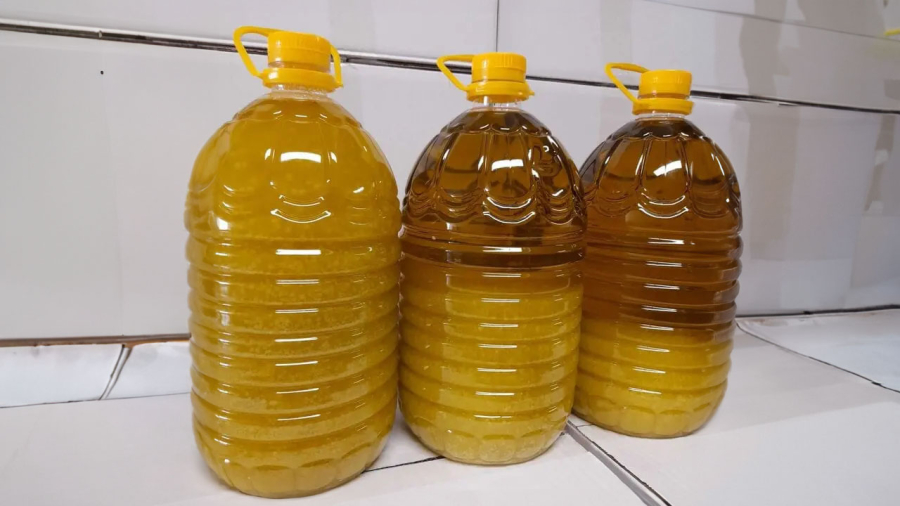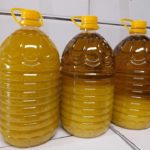When the weather is cold, many people encounter the phenomenon that cooking oil freezes and the bottle remains solid. This makes many people worry if the quality of the oil is poor, will it freeze?
In fact, cooking oil freezing in cold weather is just a normal physical phenomenon and does not affect the quality. Each type of cooking oil has a different freezing point, which is related to the composition of fatty acids in the product. If the saturated fatty acid content is high, the oil is more likely to freeze. Cooking oils that contain more unsaturated fatty acids have a lower freezing temperature. The chemical properties of cooking oil do not change when it freezes, so it does not affect the quality.
Some cooking oils freeze quickly within a few minutes at low temperatures, such as sesame oil, coconut oil, peanut oil, palm oil, etc. There are also types of cooking oils that can withstand freezing for a few hours, days, or even weeks, such as soybean oil, rapeseed oil, sunflower oil, rice oil, etc.

Many people worry about cooking oil freezing
The fact that cooking oil freezes does not affect its quality or health, it is just that different types of cooking oil have different freezing points. However, consumers should remember that cooking oil that meets the standards will not freeze the entire bottle because the composition of the fatty acids in cooking oil is diverse, so it does not freeze uniformly like lard. At the same temperature and environment, the solidification level of the same batch of cooking oil products may be different, resulting in bottles with different levels of freezing.
In summary, any type of cooking oil will naturally freeze at low storage temperatures. This is a physical state change and does not involve any chemical reactions.
How to choose high-quality cooking oil
Look at the unlabeled part for at least 5 seconds: When buying cooking oil, you should look at the unlabeled area to observe the color and transparency of the oil. Good cooking oil should have a natural color. Different types of cooking oils made from different plant sources will have different colors. Peanut oil often has a yellow-orange color, while rapeseed oil has a slightly greenish yellow color. A good bottle of cooking oil should have: low water and impurity content, no turbidity, and high transparency. Therefore, if you see turbidity, bottom freezing, or floating foreign particles, do not buy it, even if it is from a familiar brand.
Test the oil on your hand: When you buy cooking oil and want to assess its quality, you can dip your finger in the oil and test it, and smell it. Good oil will not have a strange smell, rancid odor, or fishy smell. Even if a branded cooking oil has an unusual smell, do not buy it, as it indicates poor production by that brand or low-quality oil batch. For cooking oils made from peanuts, sesame, soybeans, olives, etc., if you are observant, you may detect the distinctive aroma of these types of grains.
Give priority to branded cooking oils, but pay attention to the label: Cooking oils have many processing technologies. You should buy cooking oil from reputable brands. When buying, you still need to pay attention to the label because counterfeit technologies are very sophisticated nowadays. You should check if there are any unusual signs on the label, such as a blurry label, uneven characters, untidy writing, spelling mistakes, etc. These may be signs of counterfeit cooking oil, especially when buying from mobile vendors.
Avoid buying oil in cans: This type of oil may be self-recycled oil that does not follow any standards and has a high risk of being recycled from repeatedly used frying oil. When in doubt, call the phone number printed on the label, or check for a QR code and scan to verify.
Properly store cooking oil to maintain its quality
– Always close the cooking oil bottle tightly after use to prevent moisture and dust from getting in.
– Do not store cooking oil in wet bottles or jars because they may contain many bacteria that can cause the cooking oil to deteriorate and spoil quickly. If you want to transfer cooking oil from a large bottle, it should be stored in a clean, dry bottle.
– Store cooking oil in a cool, well-ventilated place, away from direct sunlight or high humidity.
– Avoid placing cooking oil near the stove as it will quickly oxidize. If you expose cooking oil to light, heat, and air for too long, it can become toxic.
– Do not pour leftover cooking oil back into the bottle. It is best to use cooking oil within 8-10 months after opening.

































